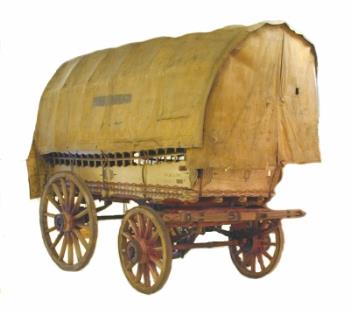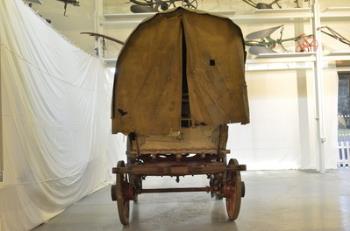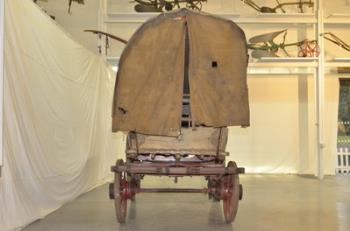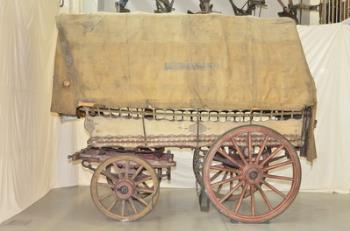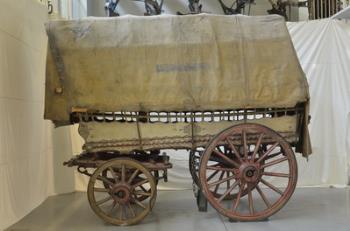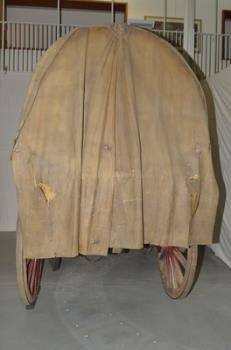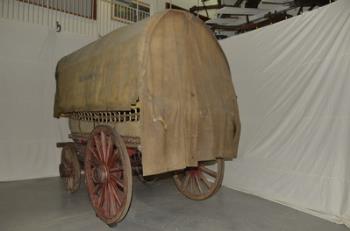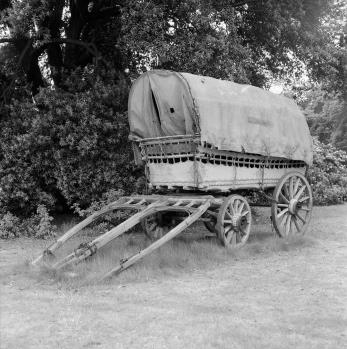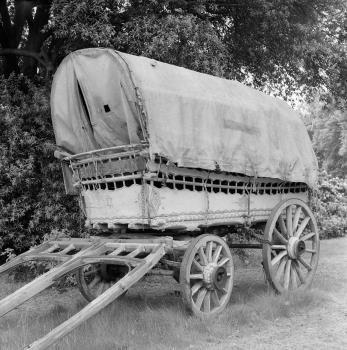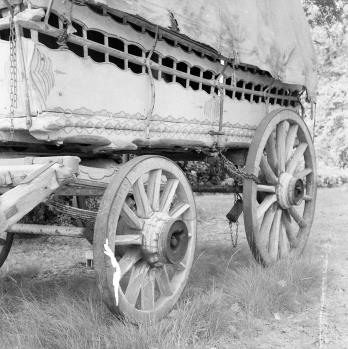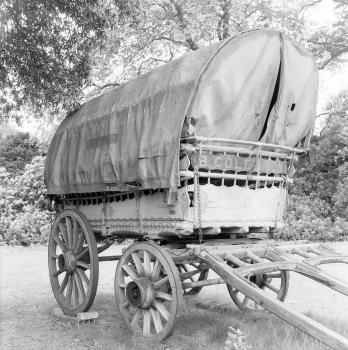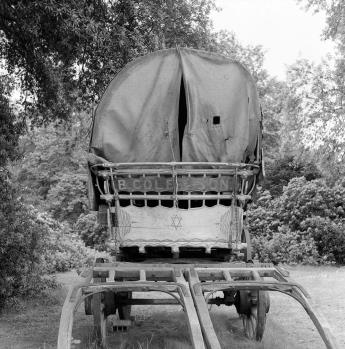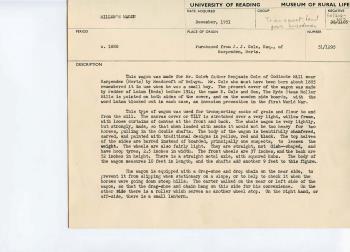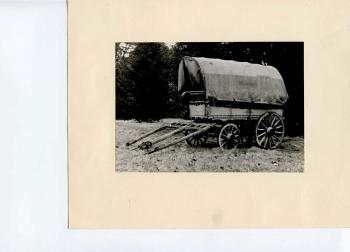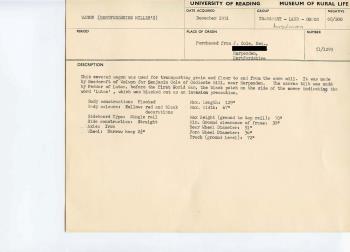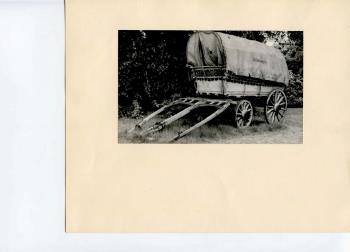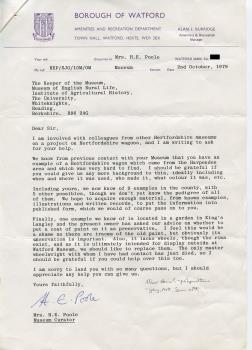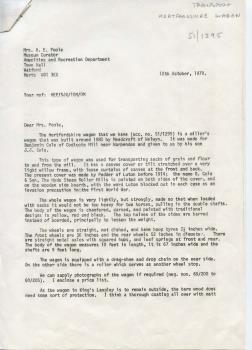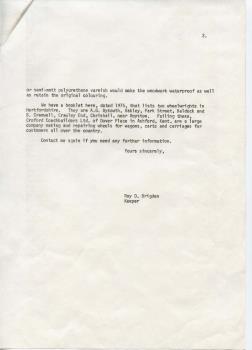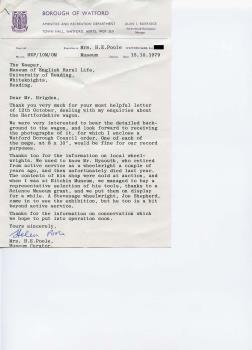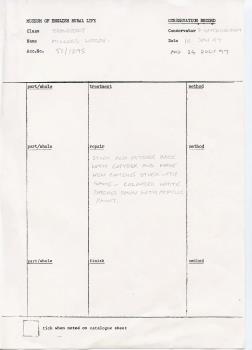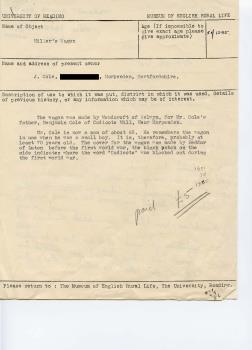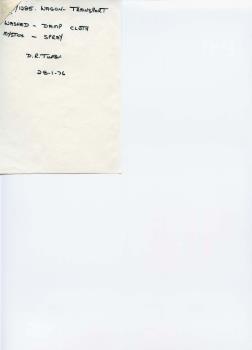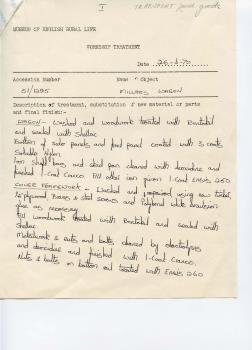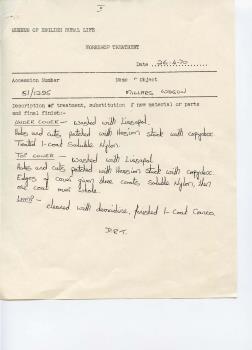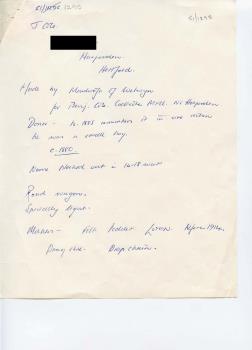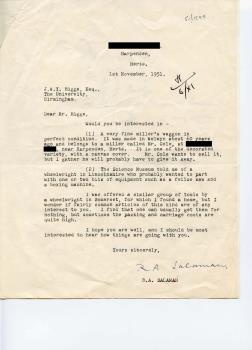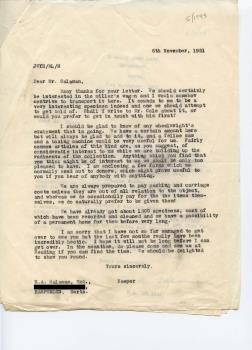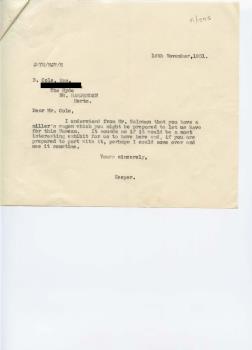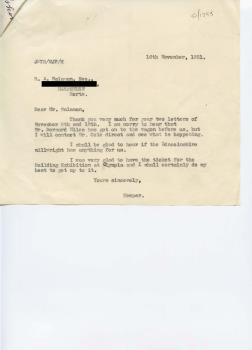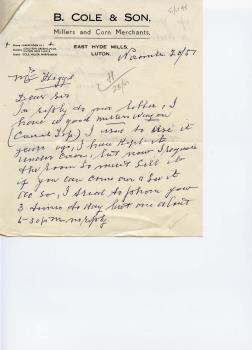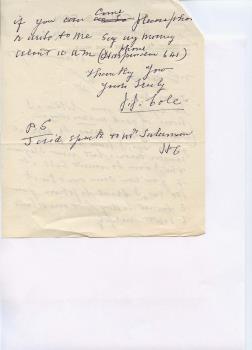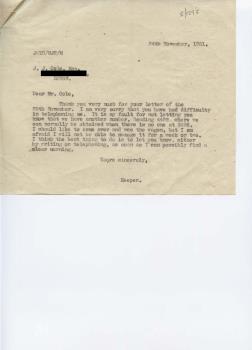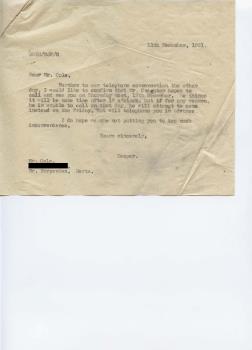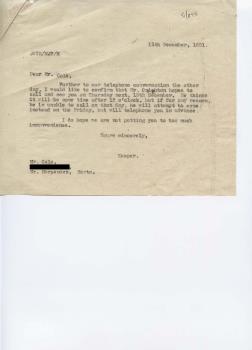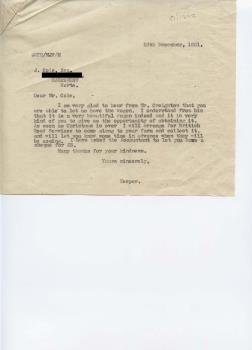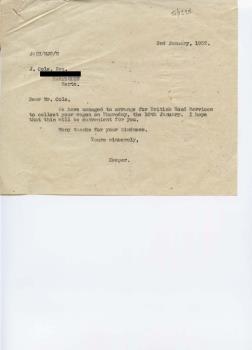Номер объекта
51/1295
Создатель
Описание
This is a miller’s wagon from Hertfordshire. It was used for transporting sacks of grain and flour to and from the mill. It is light, but very strong, so that, when loaded, it would not be too heavy for two horses to pull it. It was made in the late-nineteenth century by Meadcroft of Welwyn for the donor’s father, Benjamin Cole, of Codicote Mill, Hertfordshire. The canvas cover, or ‘tilt’ was made by Pedder of Luton and is painted with ‘B. Cole and Son, The Hyde Steam Roller Mills’. The word ‘Luton’ has been blacked out as part of the anti-invasion tactics during World War One to confuse the enemy. The wagon is also equipped with a drag shoe and drop chain.
Физическое описание
1 wagon: wood (willow); metal (iron); canvas
This wagon transported flour from a watermill at the bottom of a steep hill to a railway at the top. It was used during the First World War, when the sign on the side was blacked out due to fears of invasion. The star was a decorative or trade device, not a religious symbol.MILLERS WAGON // DETAILS // Categories Wagon Walk // Theme(s) Food and drink, People, Transport // Collection Wagons, carts and carriages // Date c.1880 // Object number 51/1295 // DESCRIPTION // This is a Miller’s wagon, owned by a man called Benjamin Cole. He ran the Codicote and Kimpton mills near Luton, on the Hertfordshire border. He had to abandon both of these mills because the River Mimram became too low to power their milling stones. // Benjamin also owned Hyde Mill, which drew its water from another river. It was located down the road from the railway, a great advantage over other mills as it meant he could export his flour to town and city centres. The road to the railway was steep and his wagon would often carry three tons. Two horses were needed to pull it when fully loaded. // The wagon also has a six-pointed star on its front. Rather than being a Jewish symbol, it is believed to simply be decorative.
Архивная история
MERL 'Catalogue index' card – 'This wagon was made for Mr. Cole’s father Benjamin Cole of Codicote Mill near Harpenden (Herts) by Meadcroft of Welwyn. Mr. Cole who must have been born about 1885 remembered it in use when he was a small boy. The present cover of the wagon was made by Pedder of Luton (Beds) before 1914; the name B. Cole and Son, The Hyde Steam Roller Mills is painted on both sides of the cover, and on the wooden side boards, with the word Luton blocked out in each case, an invasion precaution in the first World War. // This type of wagon was used for transporting sacks of grain and flour to and from the mill. The canvas cover or TILT is stretched over a very light, willow frame, with loose curtains of canvas at the front and back. The whole wagon is very lightly, but strongly, made, so that when loaded with sacks it would not be too heavy for two horses, pulling in the double shafts. The body of the wagon is beautifully chamfered, carved, and painted with traditional designs in yellow, red and black. The top halves of the sides are barred instead of boarded, principally one suspects, to lessen the weight. The wheels are also fairly light. They are straight, not dish-shaped, and have hoop tyres, 2.5 inches in width. The front wheels are 37 inches, and the back are 52 inches in height. There is a straight metal axle, with squared hubs. The body of the wagon measure 10 feet in length, and the shafts add another 9 feet to this figure. // The wagon is equipped with a drag-shoe and drop chain on the near side, to prevent it from slipping when stationary on a slope, or to help to check it when the horses were going down steep hills. The carter walked on the near or left side of the wagon, so that the drag-shoe and chain hang on this side for his convenience. On the other side there is a roller which serves as another wheel stop. On the right hand, or off-side, there is a small lantern.', MERL 'Catalogue index' card – 'This covered wagon was used for transporting grain and flour to and from the corn mill. it was made by Meadcroft of Welwyn for Benjamin Cole of Codicote Mill, near Harpenden. The canvas tilt was made by Peddar of Luton, before the first World War, the black patch on the side of the cover indicating the word ‘Luton’, which was blacked out as an invasion precaution.', Letter, Ben Cole to Oliver Douglas, 23 September 2015 – 'B. Cole & Son // Farmers and Contractors // [contact details] ... // Dear Oliver // I have finally found time to reply. Benjamin Cole was born in 1934 and died in 1908. He was apprentice at Astwick Mill in Bedfordshire and then rented Codicote and Kimpton Mills in Hertfordshire from about 1860 but then due to a lack of water he could not afford the rents so he gave them up about 1890. He was already by then renting Hyde Mill on the Herts/Beds border, which had a private railway siding which was used for importing foreign grain. the Wagon whcih we believe was made in Welwyn was used to transport the flour out to the surrounding nearby towns and villages but could also bring grain down from the siding. // This is a small photo of Benjamin our larger one we could not reproduce. [see separate photocopy of photographic item] // If I can be of any further help please feel free to get in touch. // Yours sincely [sic. sincerely] // Ben', Photocopy of photographic item – [Photocopy provided with letter from Ben Cole dated 23 September 2015. Photocopy shows small round photographic print mounted in frame that features details of the photographer] 'F. Thurston, F.R.P.S. [Fellow of the Royal Photographic Society] // Luton & Harpenden', Printed Report – Luke Bonwick, ‘Hyde Watermill, East Hyde, Hertfordshire/Bedfordshire / NGR: TL 1324 1699 / Archaeological Buildings Survey Report' (Bonwick Milling Heritage Consultancy: March 2007) pp.1-41 (mention of wagons and carts on p.4, p.7 p.25, and p.40).
Место изготовления
Welwyn, Luton
Дата
1875-01-01 - 1899-12-31
Период создания
Late-nineteenth century
Наименование
Материал
Техника
Размерность
- Length 3280 mm
- Width 1700 mm
- Height 1800 mm
Внешняя ссылка
- L:\MERL\Objects\JISC 2012\60 series negatives\60_200.tif - High resolution image
- L:\MERL\Objects\JISC 2012\60 series negatives\60_202.tif - High resolution image
- L:\MERL\Objects\JISC 2012\60 series negatives\60_203.tif - High resolution image
- L:\MERL\Objects\JISC 2012\60 series negatives\60_204.tif - High resolution image
- L:\MERL\Objects\JISC 2012\60 series negatives\60_205.tif - High resolution image
- L:\MERL\Objects\JISC 2012\Documents\Scans\51_1295_doc_01.tif - High resolution image
- L:\MERL\Objects\JISC 2012\Documents\Scans\51_1295_doc_02.tif - High resolution image
- L:\MERL\Objects\JISC 2012\Documents\Scans\51_1295_doc_03.tif - High resolution image
- L:\MERL\Objects\JISC 2012\Documents\Scans\51_1295_doc_04.tif - High resolution image
- L:\MERL\Objects\JISC 2012\Documents\Scans\51_1295_doc_05.tif - High resolution image
- L:\MERL\Objects\JISC 2012\Documents\Scans\51_1295_doc_06.tif - High resolution image
- L:\MERL\Objects\JISC 2012\Documents\Scans\51_1295_doc_07.tif - High resolution image
- L:\MERL\Objects\JISC 2012\Documents\Scans\51_1295_doc_08.tif - High resolution image
- L:\MERL\Objects\JISC 2012\Documents\Scans\51_1295_doc_09.tif - High resolution image
- L:\MERL\Objects\JISC 2012\Documents\Scans\51_1295_doc_10.tif - High resolution image
- L:\MERL\Objects\JISC 2012\Documents\Scans\51_1295_doc_11.tif - High resolution image
- L:\MERL\Objects\JISC 2012\Documents\Scans\51_1295_doc_12.tif - High resolution image
- L:\MERL\Objects\JISC 2012\Documents\Scans\51_1295_doc_13.tif - High resolution image
- L:\MERL\Objects\JISC 2012\Documents\Scans\51_1295_doc_14.tif - High resolution image
- L:\MERL\Objects\JISC 2012\Documents\Scans\51_1295_doc_15.tif - High resolution image
- L:\MERL\Objects\JISC 2012\Documents\Scans\51_1295_doc_16.tif - High resolution image
- L:\MERL\Objects\JISC 2012\Documents\Scans\51_1295_doc_17.tif - High resolution image
- L:\MERL\Objects\JISC 2012\Documents\Scans\51_1295_doc_18.tif - High resolution image
- L:\MERL\Objects\JISC 2012\Documents\Scans\51_1295_doc_19.tif - High resolution image
- L:\MERL\Objects\JISC 2012\Documents\Scans\51_1295_doc_20.tif - High resolution image
- L:\MERL\Objects\JISC 2012\Documents\Scans\51_1295_doc_21.tif - High resolution image
- L:\MERL\Objects\JISC 2012\Documents\Scans\51_1295_doc_22.tif - High resolution image
- L:\MERL\Objects\JISC 2012\Documents\Scans\51_1295_doc_23.tif - High resolution image
- L:\MERL\Objects\JISC 2012\Documents\Scans\51_1295_doc_24.tif - High resolution image
- L:\MERL\Objects\JISC 2012\Documents\Scans\51_1295_doc_25.tif - High resolution image











